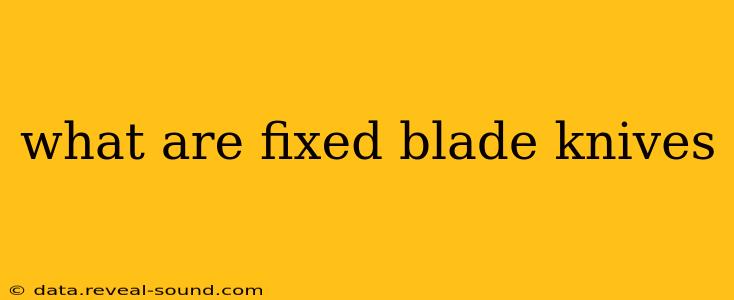Fixed blade knives are a timeless tool, prized for their strength, reliability, and versatility. Unlike folding knives, which have blades that fold into the handle, fixed blade knives feature a blade that is permanently attached to the handle. This simple yet crucial design element dictates their unique characteristics and applications. This comprehensive guide will delve into the world of fixed blade knives, exploring their advantages, disadvantages, different types, and ideal uses.
What Makes a Fixed Blade Knife Different?
The defining feature of a fixed blade knife is its rigid, non-folding blade. This construction results in several key differences compared to folding knives:
- Superior Strength: The solid connection between blade and handle provides exceptional strength and durability. Fixed blades can withstand significantly more force and abuse than folding knives, making them ideal for demanding tasks.
- Greater Stability: The fixed blade offers improved control and stability during use. This is particularly beneficial for intricate tasks requiring precision or forceful actions.
- Increased Blade Length: Fixed blades can be significantly longer than folding knives, allowing for more efficient cutting and processing of larger materials.
What Are the Advantages of Fixed Blade Knives?
The robust construction of fixed blade knives translates to several significant advantages:
- Durability: Their robust construction makes them highly resistant to damage, even under strenuous use.
- Reliability: Fixed blades are less prone to malfunction than folding knives, making them a reliable choice in demanding situations.
- Strength: They can handle tasks that would break a folding knife, such as heavy chopping, batoning (splitting wood with the knife), and prying.
- Versatility: With the right blade shape, a fixed blade can perform a variety of tasks, from food preparation to survival situations.
What Are the Disadvantages of Fixed Blade Knives?
While undeniably robust, fixed blade knives also have some drawbacks:
- Size and Weight: They are typically larger and heavier than folding knives, making them less convenient for everyday carry.
- Safety: The permanently exposed blade requires more careful handling to prevent accidental injury.
- Legality: Laws regarding carrying fixed blade knives vary widely depending on location and blade length. Always check local regulations before carrying a fixed blade knife.
What Are Different Types of Fixed Blade Knives?
Fixed blade knives come in a vast array of designs, each tailored for specific tasks:
- Hunting Knives: Often feature a drop-point blade for skinning and gutting game.
- Tactical Knives: Designed for military and law enforcement, often featuring robust construction and a variety of blade shapes.
- Survival Knives: Typically full-tang (the blade extends the entire length of the handle) and highly durable, designed for use in emergency situations.
- Bushcraft Knives: Versatile knives optimized for outdoor tasks like carving, batoning, and general bushcraft activities. Often feature a scandi grind (a type of blade bevel) for ease of sharpening.
What Are Some Common Uses for Fixed Blade Knives?
Fixed blade knives excel in situations where strength and reliability are paramount:
- Hunting and Fishing: Processing game and fish.
- Outdoor Activities: Camping, hiking, bushcraft, and survival situations.
- Heavy-Duty Tasks: Chopping, batoning wood, and prying.
- Self-Defense: (Please note: Legal implications for self-defense use vary greatly by location.)
What Materials Are Used to Make Fixed Blade Knives?
The materials used to construct a fixed blade knife significantly impact its performance and longevity:
- Blade Steel: Various types of steel are used, each offering a unique balance of hardness, toughness, and edge retention. Common examples include stainless steel, high-carbon steel, and tool steels.
- Handle Materials: Handles can be made from a wide range of materials, such as wood, bone, plastic, G10 (a fiberglass laminate), and Micarta (a canvas-micarta composite). The choice of material affects the knife's grip, durability, and weight.
How Do I Choose the Right Fixed Blade Knife?
Selecting the right fixed blade knife depends on its intended use. Consider the following factors:
- Blade Length and Shape: The blade length should suit the intended tasks, and the blade shape (e.g., drop-point, clip-point, tanto) influences its capabilities.
- Blade Steel: Choose a steel appropriate for your needs. High-carbon steel offers excellent edge retention but may require more frequent sharpening.
- Handle Material: Select a handle material that offers a comfortable and secure grip, even when wet or dirty.
- Overall Size and Weight: Balance size and weight with portability and ease of use.
Are Fixed Blade Knives Legal to Carry?
Knife laws vary significantly by location. Some jurisdictions may restrict the size, type, or carrying conditions of fixed blade knives. It is crucial to check your local laws and regulations before carrying a fixed blade knife.
This guide provides a foundational understanding of fixed blade knives. Remember to prioritize safety and always handle knives responsibly. Further research into specific blade types and materials will enhance your understanding and help you choose the perfect fixed blade knife for your needs.
